The European Federation of Geologists (EFG) conducts an annual survey of geoscientist employment across Europe and other parts of the world.
Interested AIG Members may participate by following this link.
AIG regularly collaborates with EFG in a number of areas and shares data from the Australian employment surveys to help examine trends and differences in geoscientist employment between Europe and Australia.
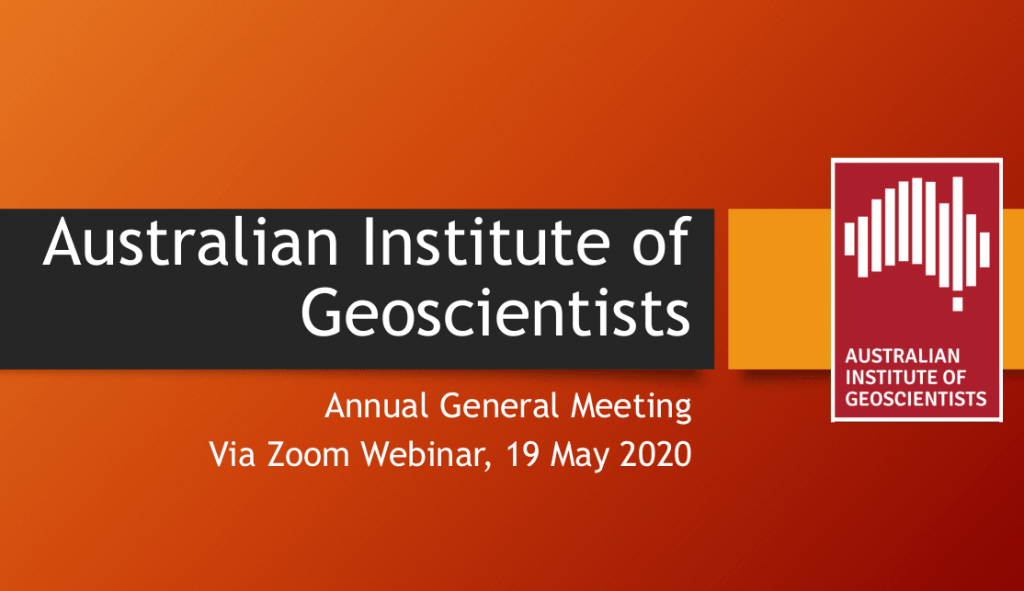
Please see below reports submitted for the 2020 Annual General Meeting.
We regret to inform members that J. David Lowell has passed away, at the age of 95.
Lowell received degrees in mining engineering from the University of Arizona in 1949, and geology from Stanford University in 1957. By 1959, he was specialising in porphyry copper exploration for Utah Construction and in 1961 became an independent consultant.
David was amongst the most successful minerals exploration geoscientists of the last 60 years, having participated in the discovery of at least 12 major ore bodies that have become major mines since, including Escondida (Chile), Toro Mocho (Peru), Pierina (Peru), and closer to home, the down-dip, faulted-off part of San Manuel/Kalamazoo in Arizona, applying the then evolving alteration zoning concept for drill targeting.
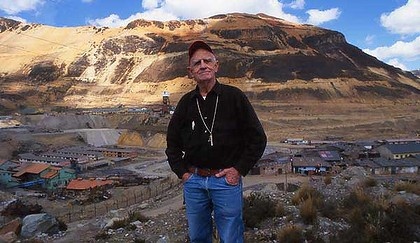
Generous endowments by J. David Lowell helped establish professional programs in economic geology and mineral resources at the University of Arizona where the Lowell Professional Programs are designed to accommodate working professionals in the mineral resources industry. Their focus is on continuing education, non-thesis master’s degrees, practical and intensive field courses, and distance learning, both live and on-demand. Programs offer a mix of geology, engineering, business, and environmental coursework.
He was the key author in the Lowell & Guilbert 1970 paper on the alteration zoning surrounding porphyry copper deposits. This zoning is amongst the most critical tools in exploring for porphyry copper deposits and, once within the porphyry, to vector where to drill next. He was the author of more than 50 published articles.
Extremely successful as an entrepreneur, David always maintained very polite and very modest manners. He was a true gentleman. His very focused and unassuming thoughts of successful exploration are described in his easy to read book ‘ The Intrepid Explorer’.
We have lost an outstanding professional, a great colleague and mentor.
Lowell is survived by his wife, Edith, as well as his daughter and two sons.
Wolf Schuh and others
Amira Global is partnering with ALTA2020 to co-ordinate a the 24hr Global Muster on Future Processing on the key issues facing mineral processing and extractive metallurgy.
Spanning a full 24 hours, Amira will host conversations, discussions, panels, workshops and roadmapping allowing the world to collaborate and shine a light on the latest advances, showcase research, development, technology, innovation and implementation.
Dr Aleksandar Nikoloski, Associate Professor, Academic Chair | Extractive Metallurgy at Murdoch University (https://www.linkedin.com/in/aleksandar-nikoloski/) will chair the Muster.

If Australian Institute of Geoscientists has technology, project or ideas to demonstrate advances in mineral processing or extractive metallurgy please email to Sara Sulway (sara.sulway@amira.global)
Please lodge your interest at https://amira.global/globalmuster-futureprocessing/ .We will get back to you with your timeslot, login and preparation information.
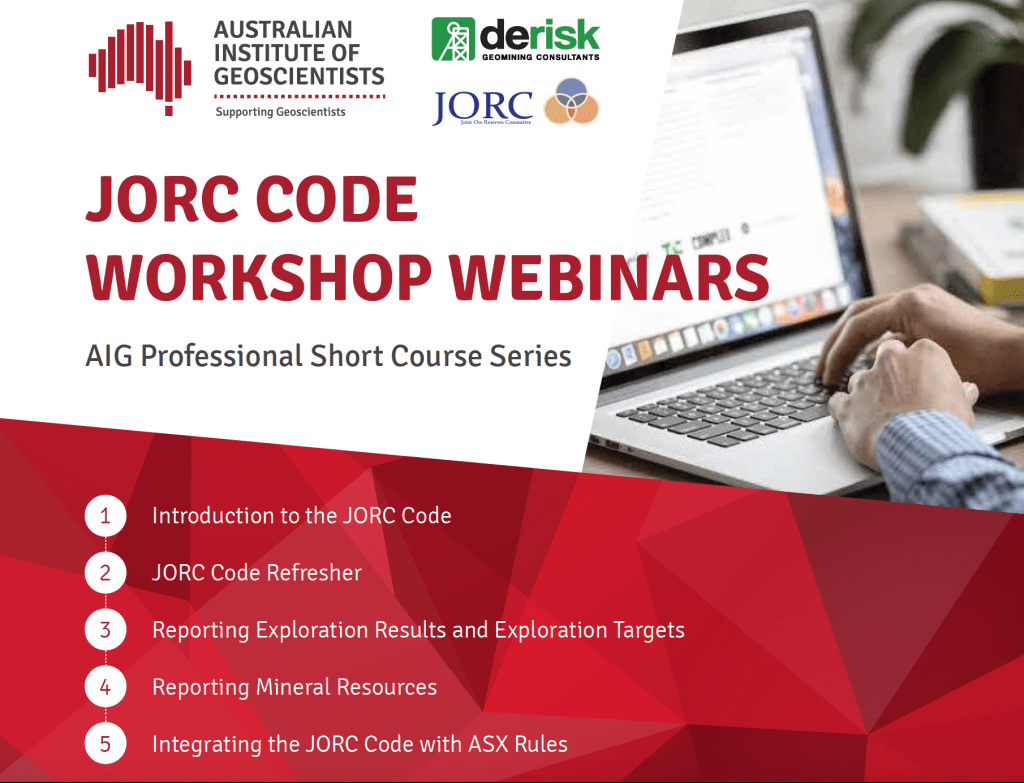
AIG has teamed with DeRisk Geomining Consultants to produce a five-module JORC training course. The first course will be delivered in May 2020. Full details of the course and registration information will be released in the next few days.

Each module will be delivered as two, two-hour, interactive webinars on consecutive days, at times designed to foster both Australian and international participation. The modular structure of the course enables participants to register for the modules that they feel they need, and to complete different modules at a time that suits them.
Individual or combinations of modules will be of interest to exploration and mining geoscientists involved in public reporting of Exploration Results, Mineral Resources and Ore Reserves in compliance with the JORC Code,, end-users of JORC reports, including legal and finance industry professionals and investors, and others involved in JORC report preparation.
Watch your inbox and the AIG web site for details.
Australian Geoscientist Employment Survey results: April 2020
Australian geoscientists reported a deterioration in employment in the first three months of 2020. Fears, however, that the coronavirus pandemic would have a deep and dramatic impact on employment, have not as yet materialised.
Unemployment amongst Australia’s geoscientists increased to 10.0% at the end of the March 2020 quarter compared to 7.3% at the end of the 2019 December quarter. Under-employment amongst self-employed geoscientists increased from 13.1% to 18.1% for the same period.
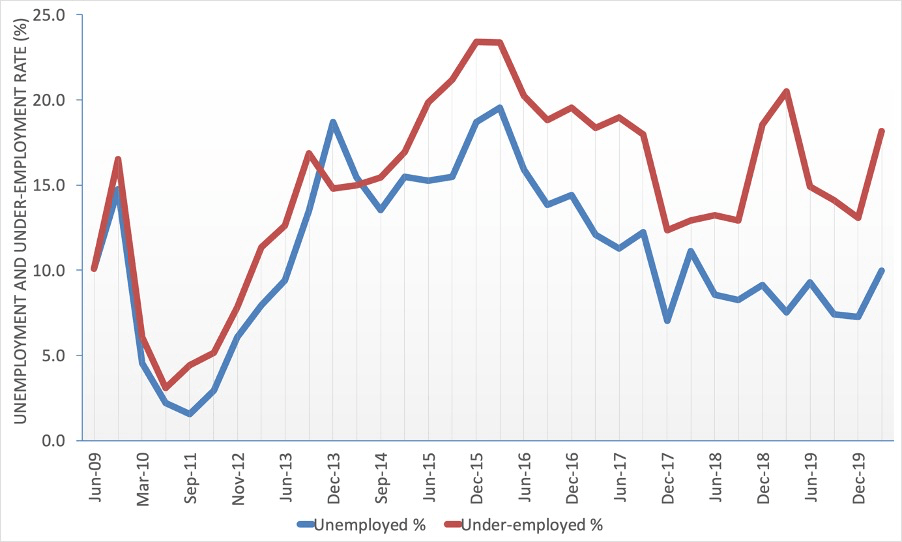
“Widespread speculation that the coronavirus pandemic would have a rapid and dramatic impact on geoscientist employment across Australia, where more than 70% of geoscientists work in mineral and energy resource exploration, mining and production, isn’t borne out by the latest survey results,” Australian Institute of Geoscientists’ President, Mr Andrew Waltho, said today.
“The first quarter of each year is frequently marked by an upturn in unemployment, with exploration fieldwork in particular reduced following the summer holidays and northern Australian wet season,” Mr Waltho said. “We have not to date seen anything like the dramatic downturn in employment associated with the global financial crisis in 2009,” he said.
“It is a welcoming sign to see that many employers, so far, have been able to retain geoscientist staff, demonstrating a commitment to both their people and business resilience, especially when the proportion of geoscientists employed by small to medium sized companies is considered.
“Geoscientists, however, haven’t escaped entirely unscathed. Self-employed geoscientists working as consultants and contractors are experiencing a downturn in their ability to secure work greater than is normally evident at this time of year, which we should expect to be reflected in exploration and mineral resource production,” Mr Waltho said.
The decline in employment nationally was not even.
Unemployment amongst geoscientists increased in every state except Queensland where unemployment was little changed between December 2019 and March 2020. Unemployment in Western Australia increased by 1.6%. The greatest increases were recorded in Victoria (11.1%) and South Australia (13.8%).
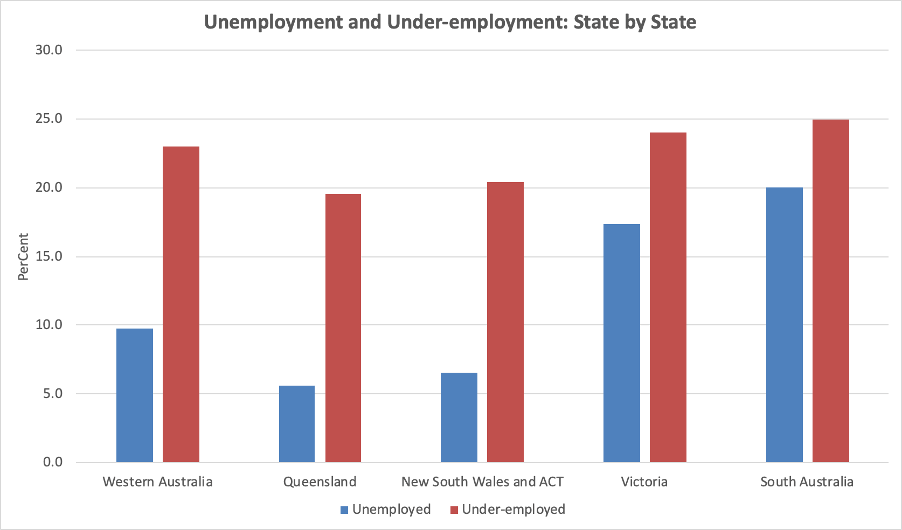
Under-employment amongst self-employed geoscientists increased significantly in all states except Queensland, where again, little change was observed in the quarter.
The contributions of mineral resource exploration, mining and energy resource exploration and production vary markedly between states.
Long-term unemployment remains the darkest aspect of the survey results with almost 29% of survey respondents reporting that they have been out of work for more than 12 months. Six percent of respondents were looking to pursue careers beyond geosciences on a long-term basis. A further 12% were seeking work to help them deal with current employment conditions affecting geosciences in Australia.
Continued professional development by geoscientists is strongly encouraged, with provision of accessible professional development resources a major focus of professional institutes, including AIG. More than one quarter of unemployed geoscientists reported that they were working to improve their qualifications and skills through formal study while unable to secure work.
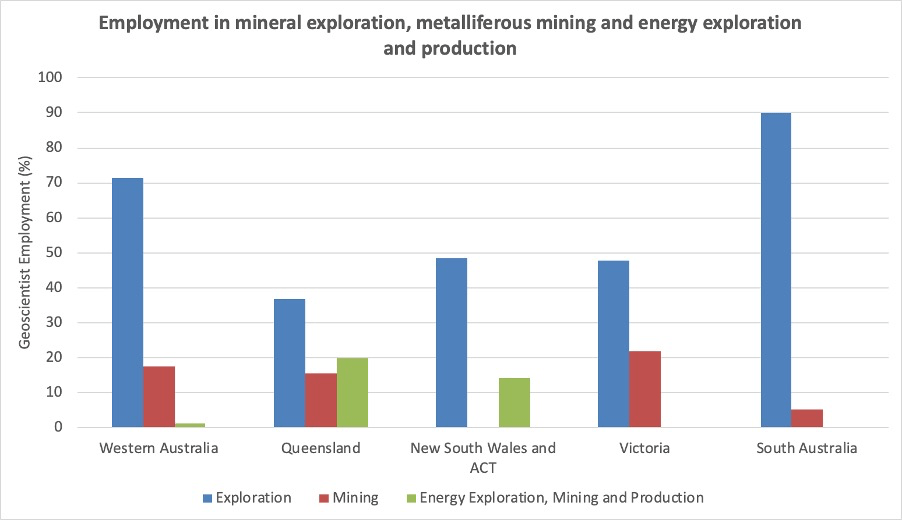
“In one sense, the survey results are re-assuring in the initial impact on employment of the coronavirus being more muted than many geoscience professionals feared,” Mr Waltho said.
“The potential for more severe impacts on employment remain.
“The situation, however, has some way to run and AIG will now be looking to the June survey to demonstrate how Australia’s minerals and energy exploration and mining industry is coping with the impacts of the pandemic.
“The need to move to a new way of working is affecting everyone in Australia to some extent.
“The AIG’s priority is to continue to deliver professional development and networking opportunities to members using on-line delivery of seminars, and short courses allowing exchange of information between members,” Mr Waltho said.
“Some of these new ways of working may well outlive the impacts of the pandemic, but ultimately geoscientists, particularly those working in exploration, need safe and effective access to land to deliver results. Returning to a safe and effective means of accessing land will be essential going forward,” he said.
The next survey will open for contributions at the end of June 2020.
AIG regrets to inform members of the passing of prominent exploration geologist and industry leader, Ken Phillips.
Ken was a living legend in many ways: geologist, executive, mentor, boss, husband, father, friend and gentleman with a quick wit and dry sense of humour to boot. He had a strong and steadfast moral compass, uncompromising principles, and a determination and unwavering commitment to his ‘team’ – traits which allowed him to achieve great success as an exploration geologist, project manager and then as a company executive later in life. It can be said that Ken had at least two “Eureka!” moments in his life, which bookend his professional career; firstly as a young geologist in the jungles of Bougainville in 1964 and secondly as a mining executive when his company was subject to a US$1.1BN takeover/merger in 2007, after which Ken gracefully entered into a much-deserved retirement.Ken is recognised as the discoverer of the Panguna copper deposit on Bougainville Island in 1964 while working for CRA Exploration (CRAE). At the time and subsequent to the mine opening in 1972, it was and still is one of the largest porphyry copper deposits in the world and it provided some 40% of PNG’s GDP whilst in operation. The mine was closed prematurely in 1989 following civil unrest on the island.
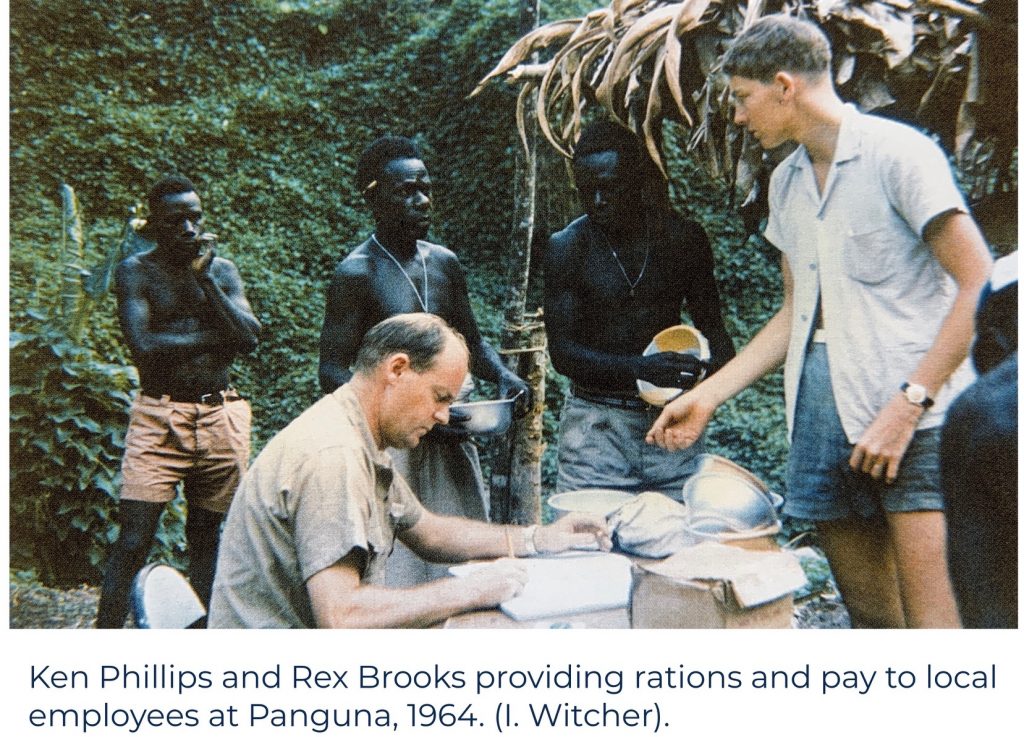
Ken’s vision and determination led to the discovery of Panguna. In 1961 he was appointed project leader of a team within CRAE that was experimenting with the new geochemical technique of stream sediment sampling and assaying with atomic absorption spectrometry (AAS) with the aim of looking for porphyry copper deposits in eastern Queensland. While on holiday in southeast Asia in 1963, Ken visited the Atlas porphyry copper mine on Cebu Island in the Philippines. It was a combination of these experiences and gifted foresight that Ken was able to recognise what Panguna was when he and his team walked into the area in April 1964. Their aim was to investigate some old gold workings that dated to the 1930s, conduct stream sediment and soil geochemical sampling programs to see if the techniques worked in tropical environments and answer the fundamental question…could there be a porphyry copper deposit in the mountain range (Crown Prince Range)? In short, the mineralisation that Ken saw in the banks of Panguna Creek reminded him of what he had seen at the Atlas mine on Cebu Island. It was his first “Eureka!” moment. As a footnote, by the end of August 1964, stream sediment and soil sampling programs had identified a four square km anomalous zone representing the footprint of the Panguna copper porphyry deposit. Success all round.
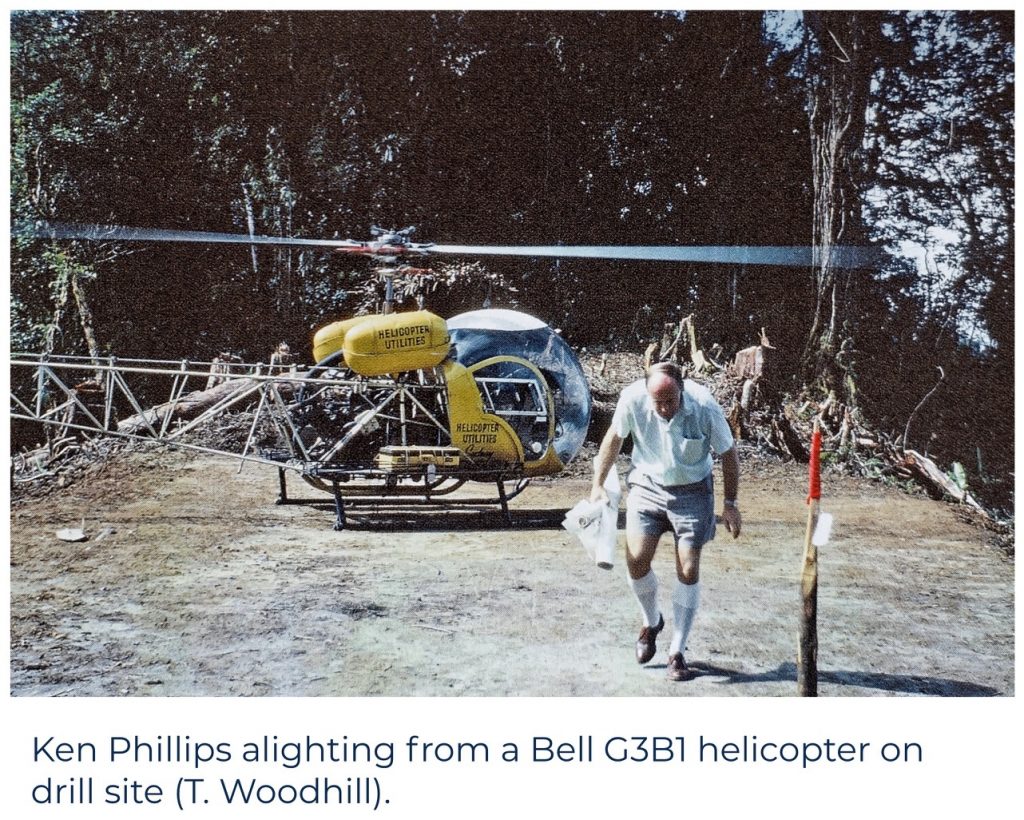
Ken resigned from CRAE in 1967 and was subsequently recruited as Project Manager for the Ok Tedi copper project in June 1969, with a remit of defining a mineable resource by the end of 1970. The Ok Tedi porphyry copper deposit is in the highlands of PNG, near the border with Indonesia and had been discovered by Kennecott Copper Corp geologists in 1968 using stream sediment geochemical sampling methods.
For the next 18 months up to late 1970, Ken provided the leadership, direction and focus the project needed and was able to define a major copper project for Kennecott.
Throughout what was a very busy time, Ken somehow found the time to meet and marry Pauline in Perth mid-September 1969. Ken and Pauline remained happily married until his passing and have two sons, namely Cameron and Tom.
Following his stint at Ok Tedi, Ken went on to run a number of mining projects for large companies throughout the Pacific Rim.
Ken’s next big success story is as an executive and begins with his partnership with Norm Seckold, a serial and highly successful, mining entrepreneur based in Sydney. Norm and Ken had teamed up prior to starting Bolnisi Gold NL, a small company at the time with mining assets in the Republic of Georgia (FSU), in the mid-1990s. However, it was following a visit to the Madneuli porphyry copper mine and surrounds in southern Georgia that Ken described the prospectivity of the area as being like a “Garden of Eden”. Bolnisi Gold was subsequently formed and named after a town nearby, and the company went on to successfully build a gold mining operation, treating gold-rich “waste dumps”. The waste dumps had been neatly and systematically stockpiled based on gold grade, by the operators of the copper mine that started in 1975.
In the early 2000s Bolnisi ventured into Mexico by purchasing the historic, silver-rich Palmarejo mine in Chihuahua state. For the next [three] years Ken and his team drilled, expanded the reserves and began developing the mine ahead of a US$1.1BN takeover by Coeur d’Alene in mid-2007. This was Ken’s second “Eureka!” moment and a fitting end to a long and highly successful career as geologist, executive, mentor, boss, husband, father, friend and gentleman.
A legend.
Scott Marsh